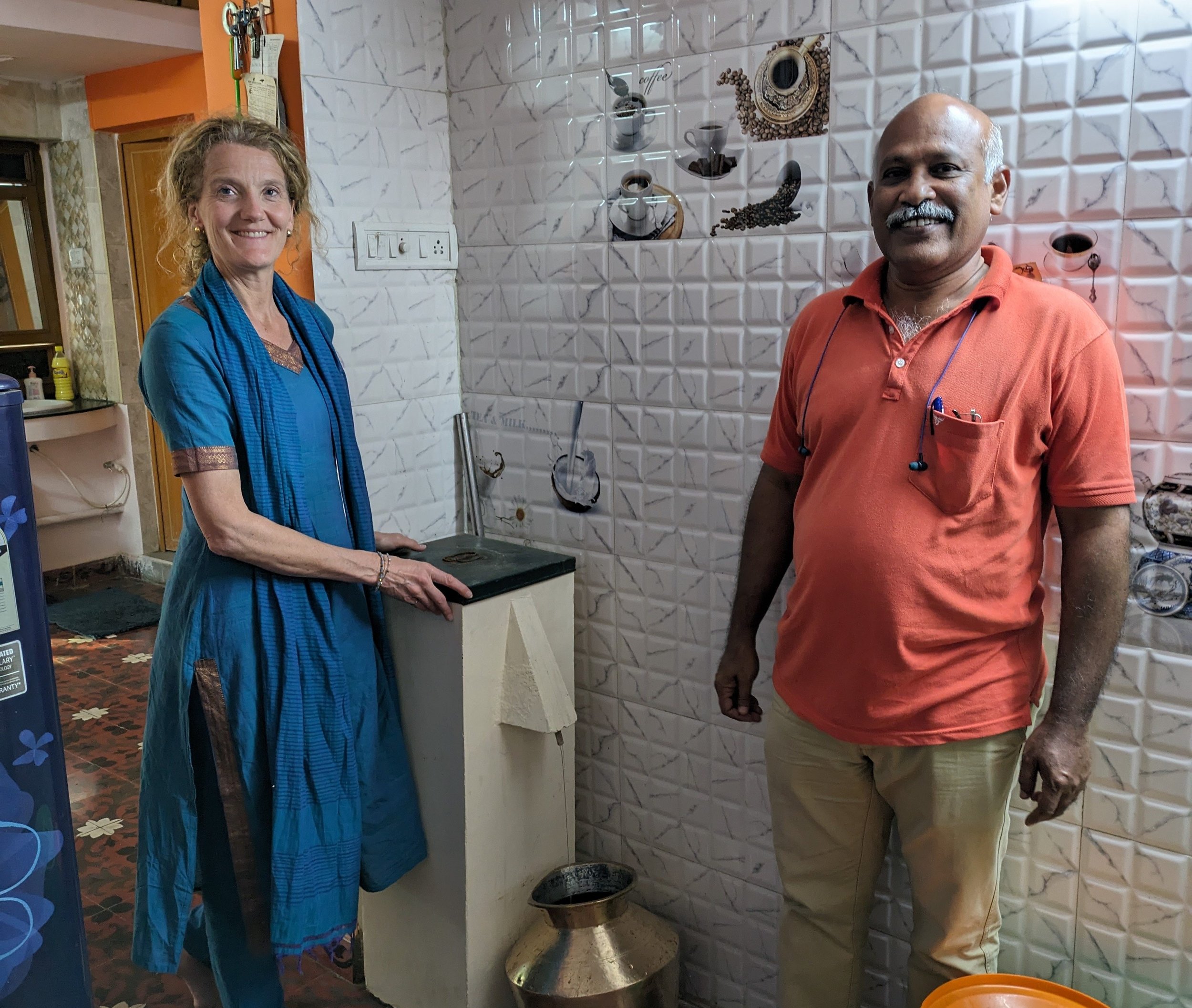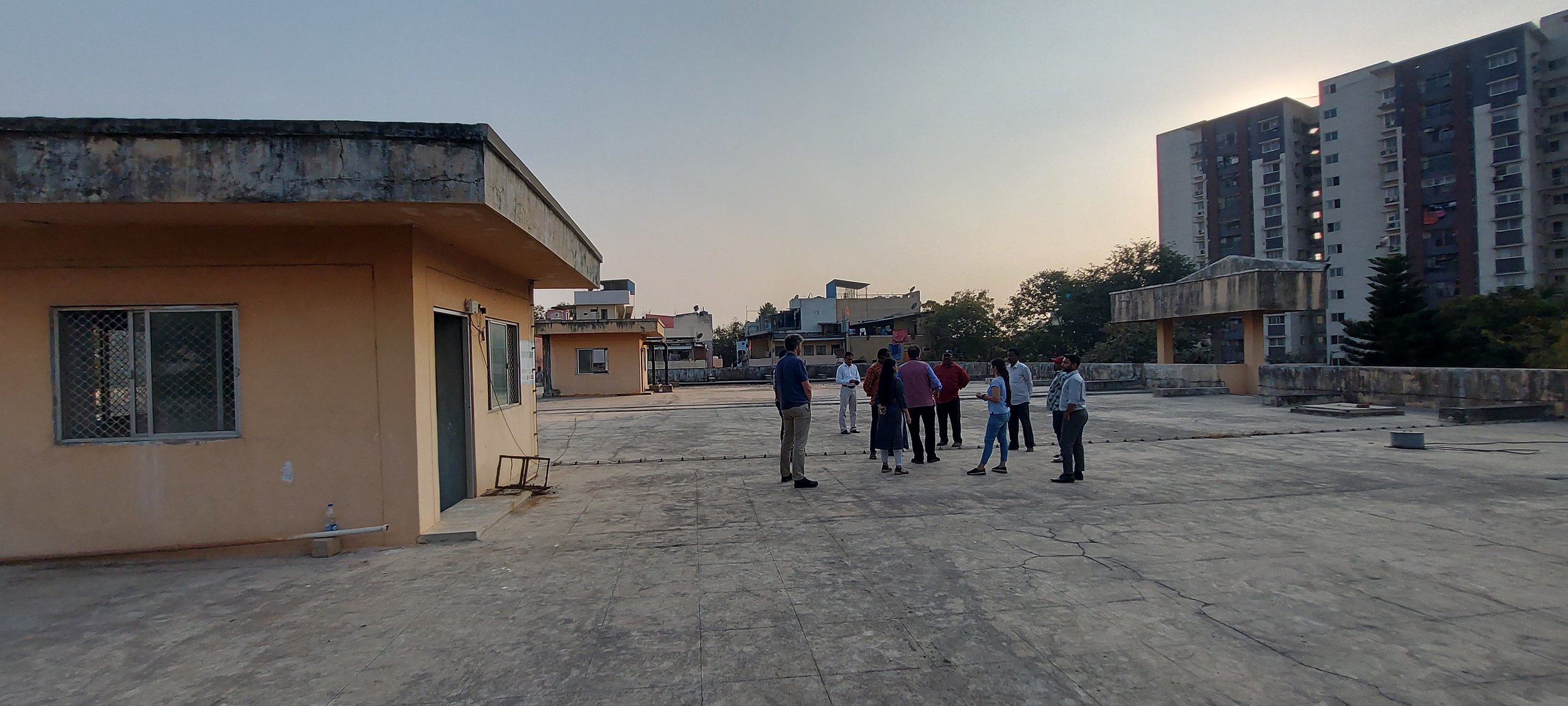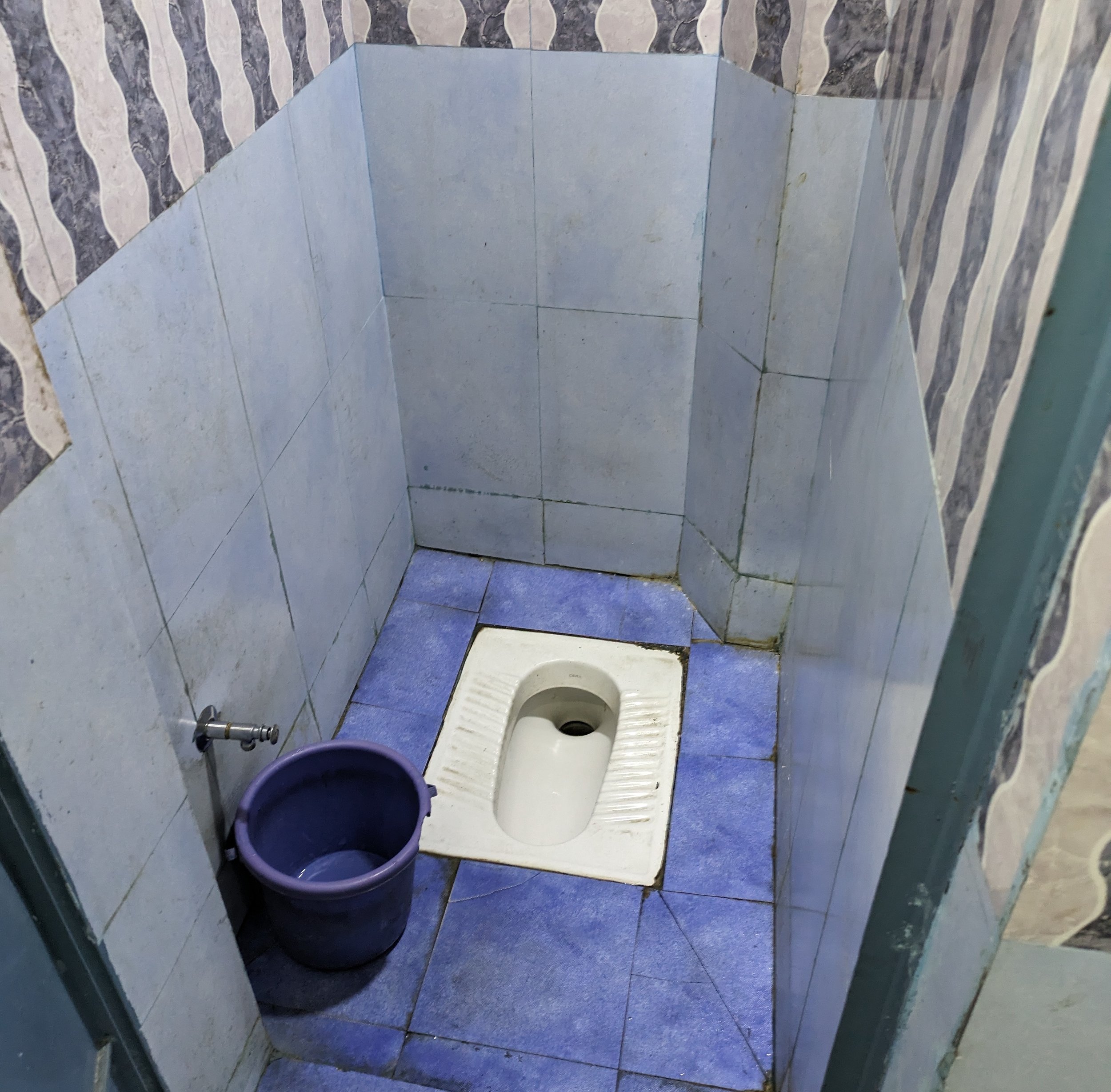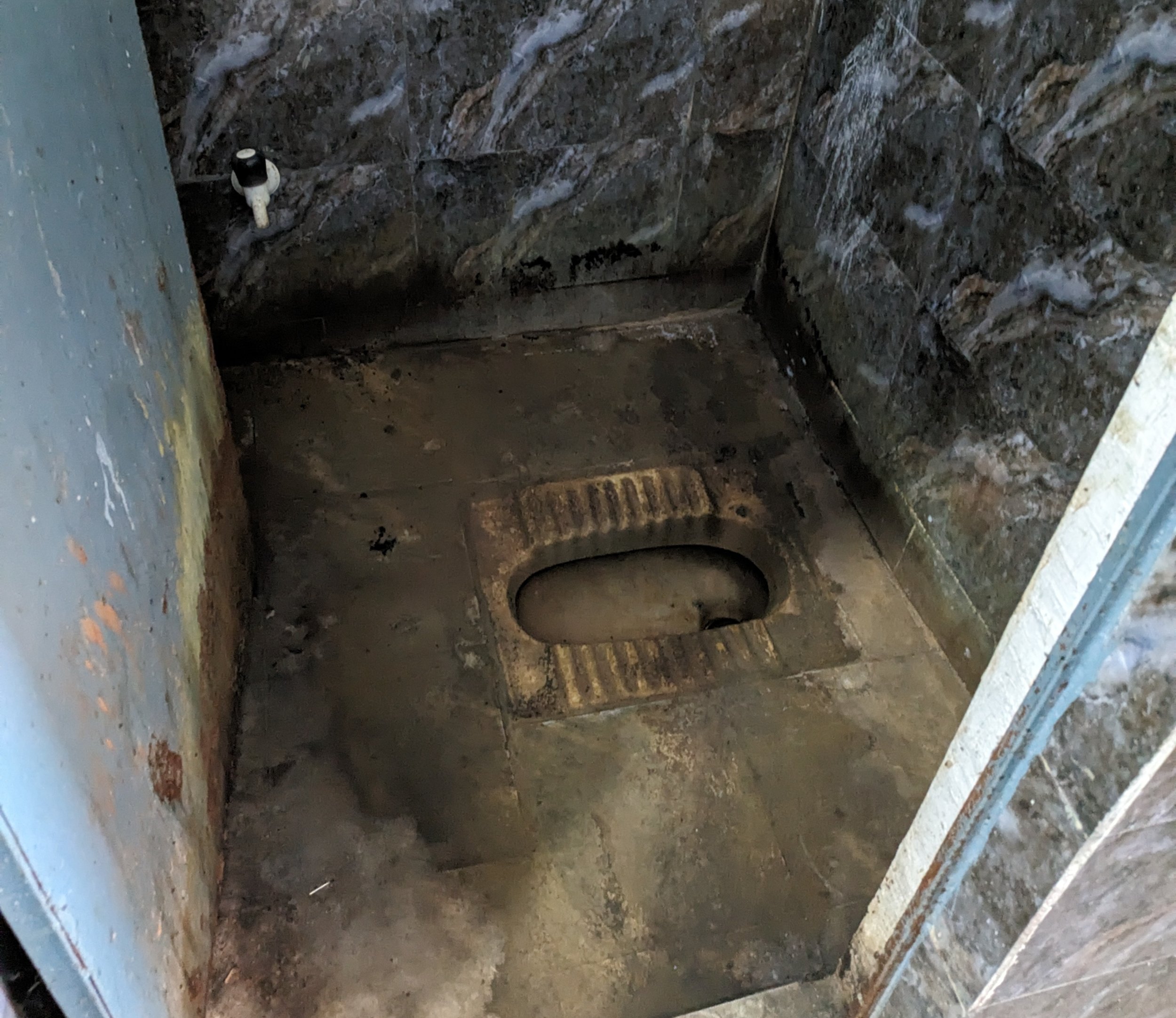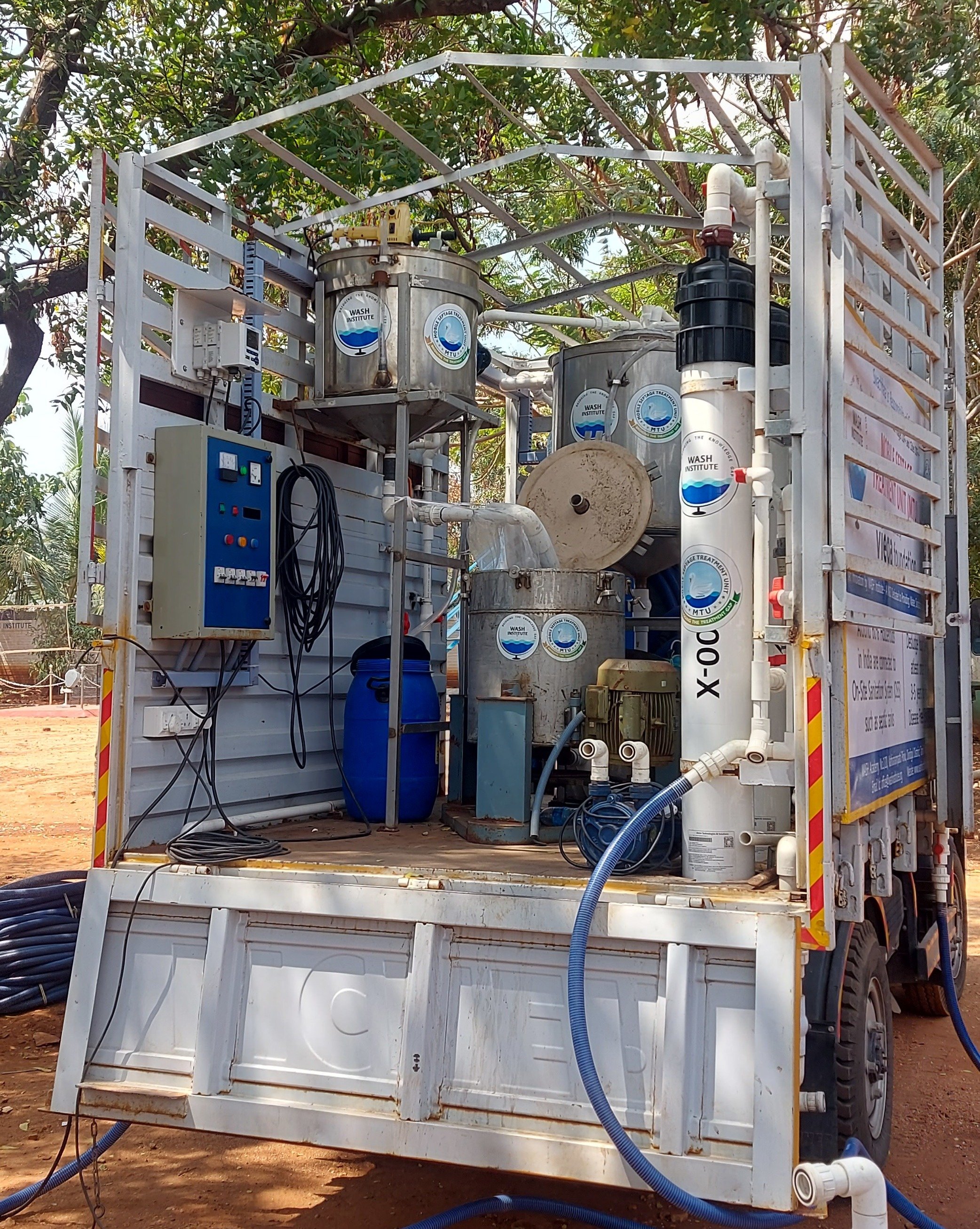Exploring Water and Sanitation Innovations in Southern India with CAWST
We’re in Southern India to learn about the reality of water and sanitation issues and solutions—from tried-and-true to emerging innovations. You’ll find a few of our highlights below. But first, we want to introduce you to R. Seenivasan and Kanagavalli in Madurai, both agricultural engineers.
Seenivasan, (Seeni), is one of the first people in the world to be trained on the biosand filter.
Featured above: Shauna and Seeni in his home where he installed a biosand filter 15 years ago. His family still uses it daily to ensure their water is safe to drink. Using rainwater as their source water and the biosand filter for treatment, they are self-sufficient.
Seeni brought the biosand filter to India in 2004 and helped define CAWST’s model as it is today.
At that time, Seeni was leading the research and development for his organization. He was seeing success with refurbishing the ancient system of collecting monsoon rains using the natural topography of the land. People’s lives were transformed as they went from limited to plentiful access to water.
Seeni started to wonder if there was a way to also make the water safe to drink. He met a student doing research on the biosand filter, contacted CAWST, and was on a plane to Canada to take one of our first workshops.
Seeni told us the biosand filter was a solution for India and invited our team to deliver a couple of workshops in Southern India. This was a turning point for CAWST. Shauna reflects:
“All of this was happening just as I joined CAWST. Seeni and I corresponded by email and then I was on a plane to India. Seeni knew more about the biosand filter than I did! He obviously also knew far more about the local context in Southern India than I ever would. He was my teacher–a guru for water, micro-finance models and development.
We met for the first time when I landed in Madurai. Seeni hosted two workshops with twenty different organizations in attendance. This solidified the distributed training model that we still use today and that we only go where we’re invited.
Kanagavalli was in the first workshops I delivered in India and quickly started apprenticing as a trainer. She and I co-delivered our first workshop in Sri Lanka. Working together with Seenivasan and Kanagavalli helped us figure out our model for developing training partners and for practical research to meet the needs in the local contexts.”
The reunion with Seeni and Kanagavalli was like reconnecting with close friends. We’ve all learnt so much over the years and are looking forward to working together again!
~ Shauna, Suneel, and Dan
Pradan Tank Tour
For centuries the people of southern India have collected the monsoon rains (between 15 days to three months per year) in “tanks” which are surface reservoirs surrounded by earthen berms. By using the natural topography of the land, the tanks are filled by channels diverted from intermittent streams and rivers that flow during the monsoon rains.
Over the centuries, many of the tanks and the channels fell into disrepair including filling up with sediment. Seeni and Kanagavalli (Kanaga) toured us through some of the areas where their organization (Pradan) has rehabilitated the tanks and channels.
Its inspiring to see these results in person! The areas rehabilitated increase access to water, improve livelihood and increase biodiversity—including attracting migratory birds from Canada!
One of the local villagers, Mr. Dhavamani, shared with us how their community's quality of life has greatly improved thanks to the rehabilitated tanks with many different advantages, including economic opportunity.
But don't take our word for it—here's a video with Kanaga translating the story told by Mr. Dhavamani during our visit (see below):
Administrative Staff College of India (ASCI)
CAWST is collaborating on a small research project at ASCI to validate sanitary inspection forms, using a risk-based approach to water safety in several Hyderabad slums that are served by the municipal water supply. As part of this, we were given a tour of a pair of water tanks that supply water to nearby neighbourhoods. Like the vast majority of India, the water supply in these neighborhoods is intermittent as people expect one to three hours of water every two to three days.
Featured above: The giant building that we're standing on is a pair of cement water tanks... imagine a gigantic indoor swimming pool! The houses receiving water from here are only a block away; other slums they will be using the sanitary inspection forms are further from the treated water…the municipal Water Board, ASCI, and CAWST are interested to see what we learn.
WhatsApp shows up again
As mentioned in the previous Global Notebook email, WhatsApp is everywhere in India. While touring the water tank pictured above, the workers shared with us how WhatsApp is used to dispatch trouble tickets to them and their teams.
Incredibly, the water board that distributes over 200 million litres of water to a city of approximately 10 million people uses WhatsApp groups to distribute and track the work done to address citizen complaints about water quality, low pressure or lack of supply across the 1450 km² area served.
WASH Innovation Hub
ASCI also shared their WASH Innovation Hub, an incubator of sorts for locally developed WASH Innovations. One example is an ultrasonic flow meter inspired by the local reality that water supply is intermittent in India.
When asked about the Dhaara Smart Meter, Vinay Chataraju of Kritsnam Technologies shared, “all of the piped water supply in India is intermittent. Sensors developed internationally that are designed for continuous flow, and don’t work for the Indian dynamic."
Here's more from our short interview with him: https://youtu.be/i4DvW1L_OMY
Community Toilet Rehabilitation and Waste Water Treatment
CDDIndia (a local organization working on nature based water and sanitation solutions) took us into a community in Bangalore. They showed us a community toilet that had been rehabilitated and connected to a decentralized wastewater treatment system (DEWATS) (see Figure 1). Nearby, we were also shown a community toilet that had not been rehabilitated and was not connected to DEWATS (see Figure 2). The difference was striking as seen in the below images.
Figure 1: clean community toilet
Figure 2: dirty community toilet
As we started to leave, the caretaker of the rehabilitated community toilet along with a few community members petitioned CDDIndia to rehabilitate the second community toilet. Our guide from CDDIndia explains that it will be complicated because of the location, with not enough space to put in a DEWATS and the funding required. Perhaps they could garner some funding to clean it up and ensure it's connected to the sewerage line.
If you want to learn more about the need for DEWATS and how the system works, check out this video from CDDIndia.
WASH Institute and the Mobile Faecal Sludge Treatment Unit
Our visit to the WASH Institute’s campus in Tamilnadu was a great end to our trip. We were excited to hear about their concrete plans to develop master trainers, gain experience in training resource development, and their clear requests for CAWST’s support that are directly in-line with our partner support model.
As part of the visit, we were given a demo of a self-contained truck mounted faecal sludge treatment unit. This innovation is a perfect example of a local initiative to respond to a local need. Over 60 per cent of sewage in India is disposed of without treatment and this treatment unit is trying to establish a market-based approach to improve this.
Above: Self-contained faecal sludge treatment truck. It has all the equipment to pump out a septic tank, separate liquids from solids, and filter the liquids to make it safe to discharge the residual liquid (water) right onto the ground. It was like magic seeing the raw sewage getting separated into dry solids and clear odorless water.
This blog is a republished version of our Global Notebook e-series. Be the first to get an exclusive inside look into our work abroad and feel like you're there alongside us. Subscribe to Global Notebook to get real-time updates straight into your inbox and hear our stories before anyone else. Travel with CAWST’s Global Advisors as they bring water and sanitation to communities around the world. Subscribe now.

